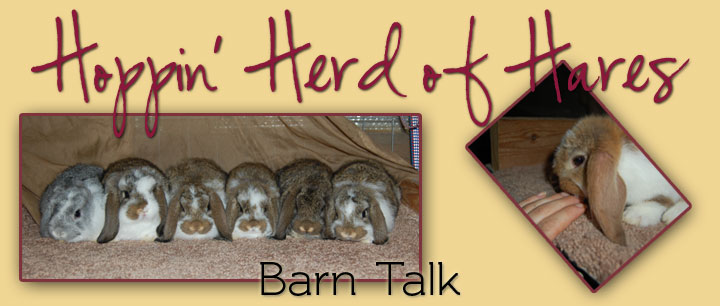Well, there's not much to report on with the rabbits. Life has been busy as usual with various things going on. But, the bunnies are all doing good.
The babies are all so cute & becoming so full of personalities! They are 5 weeks old now (wow, time flies by FAST!), so I will be getting some new pictures of them up soon. It probably won't happen until mid next week, but we'll see if I can squeeze it in before then.
I took a little peek at Daisy's babies earlier today - I think they are all going to look VERY nice. Their heads are so round, with such free-flowing crowns and their bodies are SHORT. I think it's going to be tough to decide who to keep!
We had quite a storm last night and today . . . lots of rain. This fall is much wetter than last year and MUCH cloudier. The sun has hardly been out . It was out for a little while on Wednesday until the evening when the storm rolled in.
None of my does are very eager to breed . . . :(. I haven't been in a rush to get anybody bred, but I'd kind of like to have some more litters soon. I tried breeding Sarabeth to Jake tonight. He got her once, but she wasn't really that ready. So, I think I'll put some ACV in the water of the does I want to get bred and go from there. I plan to breed Sarabeth & Champagne. Possibly Kadence also, but we'll see . . . she'll probably wait at least a month, so I can breed her to Brad. I think her and Brad will make some gorgeous babies!
My two new rabbits have started their trip and should be to their new home by next Friday (Nov. 6th) - Yay!
Qadoshyah
Thursday, October 29, 2009
Not much to report
Posted by Qadoshyah at 7:08 PM 0 comments
Thursday, October 22, 2009
Sweet Update
I received a nice email from Jaimie in Louisiana a couple days ago. Her nephew bought several mini lops from me a few months ago. Here's part of the email I received:
Just wanted to let you know that my nephew won BOB in both ARBA shows yesterday. In show A he won with the Opal doe and in show B he won with the Broken Chocolate doe. He was so excited! He had a lot of competition.It's always nice to receive emails like this!
Here's a few pictures of the beautiful fall scenes that are everywhere now ~





Qadoshyah
Posted by Qadoshyah at 2:35 PM 0 comments
Wednesday, October 21, 2009
Baby Cuteness
It's been almost 4 months since we've had any little babies here. Daisy's & Kristen's litters are at the beginning of the cute stage - 3 weeks old now. Yesterday, I finally managed to get their individual pictures and then got them up on the site today.
You can see the pictures here - Daisy's litter & Kristen's litter.
Here are a few of the pictures ~
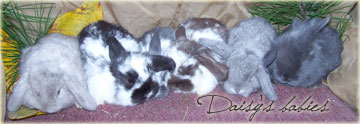
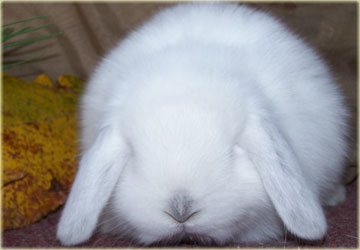
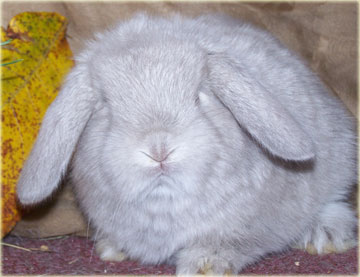 My favorite picture of them all!
My favorite picture of them all!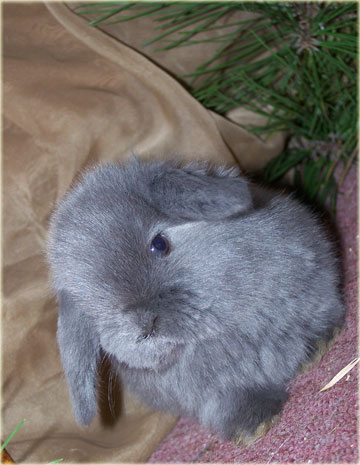
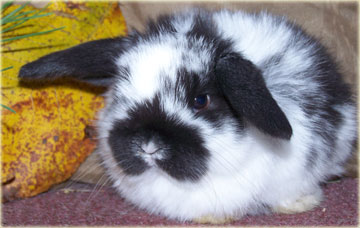
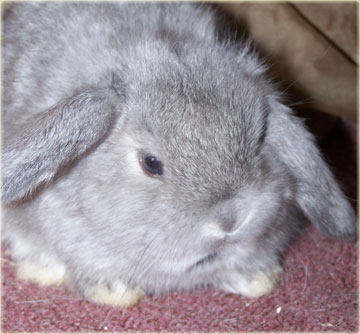
Qadoshyah
Posted by Qadoshyah at 12:22 PM 2 comments
Monday, October 19, 2009
The week has gone by fast . . .
This past week went by extremely fast and we were in and out every day last week. We'll be staying home all day tomorrow hopefully, that'll be SO nice!
My bunnies have been doing pretty good. I haven't had much time to play with them, but I have made sure to give the babies some cuddles and give them all their loved treats (like hay & oats :)).
The litters are 3 weeks old now so they are due for some pictures. Hopefully I can get those tomorrow, as I should have all day available.
I lost Kristen's little lilac baby mysteriously Friday night. It was perfectly fine just a few hours prior and was dead in the midst of it's siblings when I checked them before I went to bed. I don't have a clue as to what happened, as it looked completely fine and normal. She was a very cute baby too!
All of Kristen's are does and the two "pinks" are both pointed whites. I can't tell for sure if one of the pointeds is a dilute or not, but I'm leaning towards not. Daisy's babies are 4 does, 2 bucks.
Hopefully more tomorrow,
Qadoshyah
Posted by Qadoshyah at 8:48 PM 0 comments
Saturday, October 10, 2009
Update
The weather has taken a turn and it's been quite cold this week. It's about 43 degrees outside right now. I know once winter hits, 43 will feel warm, but right now it feels pretty cold!!
It rained for about 13-15 hours straight from Thursday evening to Friday morning. Yeah, needless to say the creeks were overflowing. It was pretty windy here too and COLD, so I had to do the oh so fun job of securing all the tarps on the barn so that the wind doesn't get through to the bunnies. Everyone seems to be doing pretty well!
Because of the cold, I had to bring in Daisy's babies because they are at the age where they like to get out of the box, but they aren't big enough to get back in and they could freeze. One of Daisy's smaller babies is very hyper and likes to get out by himself, so he would very likely get WAY too cold and I'd lose him. He's the most adorable little baby too - so tiny, but with a HUGE head (that's a Deckles kid for ya ;)).
This week has been crazily busy and so will next week, but hopefully I can get some more pictures of both litters at some point next week. For now, I'll leave ya with a couple pictures of Daisy's little munchkin's (the blue & lilac chins) ~



Qadoshyah
Posted by Qadoshyah at 10:01 AM 0 comments
Monday, October 5, 2009
Color Projects
On a rabbit breeder forum I am on, the topic of adding a new variety into someone's herd came up. This particular breeder who was considering doing this is very new to raising rabbits and already has one interesting variety in her breed. So, I thought I would give a little bit of information from my experience in working with colors for years now.
Shortly after starting raising my mini lops, I chose a color project - chocolates & lilacs. I also, not really by choice, had reds & tri colors going (a whole different project). Having both those projects going at the same time and both of them needing much work in their body type, it was way too much and way too overwhelming working with both right away.
I had to sell out of the reds and tris to focus on getting the type there on my herd and the one color I had chose. It was one of the best decisions I have made in my years of breeding. I strictly focused on that one project for a couple years and made A LOT of progress before I even *considered* bringing in another project. And, even that new project that I brought in (pointed whites), I brought in on a small, slow scale. I had wanted to work with the pointed whites for awhile, but it was not feasible for sometime for several reasons.
My main herd (largely consisting of chocolates & lilacs) needed a lot of work in their line. They needed help in establishing consistency in the barn. I needed to bring in other good reputable lines (regardless of color) to help get their type better. Working with two hugely different varieties (chocolates & tris) at the same time, with both needing LOADS of work on their type, was just too crazy to do. They couldn't really be bred together because they both had so many faults and both needed too much work.
I finally did bring in the pointed whites, but like said above, on a small, slow scale. I would still really like to bring back in reds, but I will not do it until I have adequate cage space and I feel it would be good for my herd. Over the years I have frequently considered bringing in the tri colors again, but everytime I come back to the same conclusion: it would be way too much, with my small rabbitry, and other color projects, to bring them in. They aren't compatible with several of the colors I currently have in my barn, so it just would not work. Reds, on the other hand, are compatible with MOST of the colors in my barn.
For new breeders, it is very important that you get the type on your herd first, see consistency, get your line & type defined before you consider adding in too many color projects. Color projects, which are very fun & rewarding, often times take a lot of patience, diligence and work to get them where they are able to compete with the "main" varieties in a particular breed.
Thankfully, I can say that the work it has taken to get the chocolates & lilacs with great type over the past 5 years is paying off and has been for a couple years. I just received word from a youth breeder in California that the broken chocolate buck, Hoppin's Java Chip, she got from me as a baby last December granded this past weekend! Congrats Allison!
But, some color varieties take a lot more work to get them to where they need to be. Like the pointed whites. In December it'll be 3 years since I started this project. Their type has come A LONG ways, but there is still a lot that needs help.
Qadoshyah
Posted by Qadoshyah at 8:41 PM 3 comments
Labels: breeding rabbits
Friday, October 2, 2009
Rabbit Genetics: Basic Terminology
*NOTE* These terms are for ALL genetics. They are not particular to certain genetics, they apply to all.
Here are some of the basic genetic terminologies. I will mention these first that way you can understand what I am referring to at times.
Allele - See Locus
Carry - This means that a rabbit is hiding a gene for another color. It can hide a recessive gene. It cannot hide a gene that is from a different locus, it has to hide a gene from it’s own locus.
Chromosomes - The genetic make up if cells that reproduce themselves. This is where the DNA is. A domestic rabbit has 44 chromosomes (22 pairs), cotton tails have 42, and hares have 48.
Dominant - A dominant gene is stronger than a recessive gene. A dominant gene always shows up first. For example, if a chestnut agouti (castor, sandy, etc) carries self (non-agouti) the rabbit would appear as a chestnut agouti. The self gene will not show.
Genotype - The genetics of a rabbit. For example the genotype of a chestnut agouti is: A_B_C_D_E_
Heterozygous - This means that the rabbit is not pure for a certain gene. It carries a recessive gene. For example, “Aa” instead of “AA”.
Homozygous - This means that the rabbit is pure for a certain gene. It does not carry a recessive gene and it cannot produce certain colors. For example, “AA” instead of “Aa”.
Locus (plural - Loci) - This is the position of the gene on a chromosome. It is the series or set that certain genes are located in. Each locus has a specific letter name. For example, A Locus, B Locus, etc. Genes from one loci cannot be dominant or recessive to genes from another loci. There can only be two genes on one loci. One gene per locus is donated from one parent and the other gene is donated from the other parent to fill the 2 “slots” on the chromosome.
Modifier - This is a type of gene that is linked up with a certain gene and it modifies that gene. An example, is rufus modifiers. A rabbit with more rufus modifiers will have a deeper, darker, red coloring (e.g. Red). A rabbit with fewer rufus modifiers will have lighter, duller red color (e.g. Fawn). Rufus modifiers are shown as plus (+) and minus (-) signs. A rabbit with more plus signs will have darker color, a rabbit with more minus signs will have lighter color, and a rabbit with an equal amount will have medium color.
Phenotype - What the rabbit looks like. For example, I have a buck who looks (phenotype) like a broken chocolate but, his genotype is a broken chocolate steel.
Recessive - This is a gene that is weaker than a dominant gene. A recessive gene can hide behind a dominant gene but, it cannot hide a dominant gene.
Posted by Qadoshyah at 1:16 PM 1 comments
Labels: rabbit genetics
Rabbit Genetics: Vienna & Broken
The V Locus:There are two genes in the V Locus. The most dominant is “V” and the most recessive is “v”.
The Broken (En) Locus:
~ Non-Vienna
“V” is called the Non-Vienna gene. This gene can be homozygous or heterozygous. This gene creates the normal color that is seen in all colors except Blue-Eyed-White (BEW). Some of the colors that have the Non-Vienna gene are as follows:
All varieties except Blue-Eyed-White (BEW).
Non-Vienna can carry Vienna. Non-Viennas that carry the Vienna gene are called Vienna Carries (VC).
~ Vienna
“v” is called the Vienna gene. This gene can only be homozygous. It cannot carry any other gene as a recessive gene cannot carry a dominant gene. This gene masks all other genes leaving the coat white and turning the eyes blue. Some of the colors that have the Vienna gene are:
Blue-Eyed-White (BEW)
~ Incompletely Dominant (Vienna Marked, Sports)
When the Non-Vienna gene is paired with the Vienna gene the animals will often have white markings with their regular color. Some of the time the markings are similar to Dutch markings but, sometimes they just have white spots in different areas. The reason for this is because the Vienna gene is incompletely recessive to the Non-Vienna gene so, that when it is paired with the Non-Vienna gene sports are the result. Vienna Marked animals or Sports have the following genotype, “Vv”. Sometimes these sports will not show any sport markings but, a lot of the time they do.There are 2 genes in this locus. The most dominant is “En” and the most recessive is “en”.
Qadoshyah
The broken genetics are incompletely dominant. To get a normal broken pattern, you need one broken (En) gene and one solid (en) gene. If you have two broken genes, then it is what is referred to as a Charlie. A Charlie pattern broken was named after Charlie Chaplain because they often have a little Charlie Chaplain moustache, and they often only have a small stripe of color down the center of their back. A Charlie a Charlie you need two broken (EnEn) genes. To get a solid you need two solid (enen) genes.
If a Charlie is bred to a solid you can only get brokens. The reason is because the Charlie is “EnEn” and the solid is “enen”. Brokens need one broken gene and one solid gene (Enen). A Charlie is not possible out of a solid x Charlie breeding because a solid needs 2 broken genes (EnEn) and the solid does not carry a broken gene. A solid is also not possible because a solid needs two solid genes (enen) and a Charlie does not carry a solid gene.
If a broken is bred to a solid you can get brokens and solids. You cannot get any charlies because both parents have to have a broken gene to be able to produce a Charlie. You can get solids because the broken carries one solid gene and one broken gene. The broken will have to pass the solid gene and the solid will have to pass one solid gene in order to create a solid. To get a broken the broken will have to contribute a broken gene and the solid will have to give one solid gene.
If a broken is bred to a broken you can get brokens, solids, and charlies. To get a broken one of the brokens has to give one broken gene and the other broken has to give a solid gene. To get a solid each broken has to give one solid gene. To get a Charlie each broken has to give a broken gene.
If you breed a charlie to a broken, you should get 50/50 charlie/broken. You are much more likely to get more charlies than brokens. To get a broken the broken has to give a solid gene and the Charlie has to give a broken gene.
If two charlies are bred together you can get only charlies. Both of the charlies have two broken genes and thus can only produce charlies and cannot produce brokens or solids.
Posted by Qadoshyah at 1:11 PM 0 comments
Labels: rabbit genetics
Rabbit Genetics: A-E
Since geocities will be closing this month, that means the Genetics website I had up will be closing. So, I thought I'd paste most of the info here on the blog and then it'll still be available for folks to see.
The A Locus:There are 3 genes in the A locus. The most dominant is “A”, the second dominant is “a(t)”, and the most recessive is “a”.
The B Locus:
~ Agouti
“A” is called the Agouti gene. All agouti colors have to carry at least one of these genes. If they carry two of these genes then they are homozygous (pure) for the agouti gene. Meaning they can not produce any other color except an agouti color. The agouti gene creates different bands of color in the hairshaft. It also creates the agouti markings (such as the white bellies, white inside of the ears, white lacing around the nostrils, etc). For example, a chestnut agouti (castor) has a white belly. It also has 3 colors in the hair (top layer: black, intermediate layer: red/orange, and bottom layer [undercolor]: slate blue). The following colors are some of the colors that are agouti colors:
Chestnut Agouti, Castor, Sandy Gray, Copper, Gray, Opal, Chocolate Chestnut Agouti, Chocolate Agouti, Cinnamon, Lynx, Red, Fawn, Cream, Orange, Chinchilla (black, blue, chocolate, lilac, sable, and smoke pearl), Squirrel, Tri Color, Harlequin, and all Steels (silver tipped & gold tipped, black, blue, chocolate, lilac, sable, and smoke pearl).
*A correct tri color or harlequin are agouti colors. The orange/red, fawn/cream that is seen is created by the agouti gene. When the spots that the orange/red/fawn/cream color should be are a tort color it is a self tri color/harlequin (a non-agouti based color).
The Agouti gene can also carry tan pattern and non-agouti. When the agouti gene carries tan pattern or non-agouti it is heterozygous. Meaning it is not pure for the agouti gene.
~ Tan Pattern
“a(t)” is called the Tan Pattern gene. All Tan Pattern animals have to have at least one tan pattern gene. If it has two tan pattern genes then it is homozygous for the tan pattern. The tan pattern creates the gold ticking that is seen otters. It also creates the silver ticking that is seen in silver martens. It creates the silver ticking when it is paired with the chinchilla or shaded gene. The following colors are some of the colors that have the tan pattern gene:
Tan (black, blue, chocolate, and lilac), Otter (black, blue, chocolate, and lilac), Silver Marten (black, blue, chocolate, lilac, sable, and smoke pearl), Tortoise Marten (black, blue, chocolate, and lilac), Fox (black, blue, chocolate, and lilac).
The tan pattern gene can also carry non-agouti. When the tan pattern gene carries non-agouti it is heterozygous. Meaning it is not pure for the tan pattern gene.
~ Self (Non-Agouti)
“a” is called the Non-Agouti or Self gene. All self varieties have to carry two non-agouti genes. They are automatically homozygous for non-agouti. They have to be homozygous for non-agouti because it is the most recessive gene in the A Series and a recessive gene cannot carry a gene that is dominant to it. The self gene makes the animal look all the same (unless it is paired with another gene [I.e. the shaded gene creates shading]). They do not have agouti markings (white belly, etc) like agouti colors do. Their under color is a bit lighter. For example the undercolor on a black is slate blue and the undercolor on a chocolate is dove gray. The following colors are some of the non-agouti colors:
Black, Blue, Chocolate, Lilac, Tortoise (black, blue, chocolate, and lilac), Siamese Sable (Sable), Seal, Smoke Pearl, and Sable Point.There are two genes in the B Series. The dominant one is “B” and the recessive one is “b”.
The C Locus:
~ Black
“B” is the Black gene. All colors that are not a chocolate based are black based colors and thus have this gene. They have to have at least one black gene in order to be a black based color. If they have two black genes then they are homozygous for black. Thus it could not produce any other color besides a black based color. The following colors are some of the colors that are black based colors:
Black, Blue, Chestnut Agouti, Castor, Sandy Gray, Gray, Copper, Opal, Black Chinchilla, Blue Chinchilla, Sable, Sable Point, Black Tortoise, Red, Orange, Smoke Pearl, Blue Tortoise, Sable Chinchilla, Smoke Pearl Chinchilla, Black Otter, Blue Otter, Black Silver Marten, Blue Silver Marten, Black/Orange Tri, Blue/Fawn Tri, Black Harlequin, and Blue Harlequin.
Black can also carry chocolate. When black carries chocolate it is heterozygous. Meaning it is not pure for the black gene.
~ Chocolate
“b” is the Chocolate gene. Any chocolate color must have two of these genes to be a chocolate color. They have to be homozygous for chocolate. Chocolate cannot carry black because black is dominant to chocolate and no recessive gene can carry a dominant gene. The following colors are some of the colors that are chocolate based:
Chocolate, Lilac, Chocolate Chestnut Agouti, Cinnamon, Lynx, Lilac Chinchilla, Chocolate Chinchilla, Chocolate Otter, Lilac Otter, Chocolate Tortoise, Lilac Tortoise, Chocolate Silver Marten, Lilac Silver Marten.In the C Locus there are 5 genes. “C” is the most dominant gene, “c(chd)” is the second dominant gene, “c(chl)” is the third dominant gene, “c(h)” is the fourth dominant gene, and “c” is the most recessive gene.
The D Locus:
~ Full Color
“C” is called the Full Color gene. The full color gene can be homozygous for “C”. If it is not homozygous for “C” then it is heterozygous. The full color gene creates the one color that we see in blacks, blues, oranges, etc. Some of the colors that have the full color gene are as follows:
Black, Blue, Chocolate, Lilac, Otter, Chestnut Agouti, Opal, Orange, Tortoise, Castor, Lynx, Cinnamon, Chocolate Chestnut Agouti, Tri Colors, and Harlequins.
The full color gene can carry Chinchilla Dark, Shaded (Chinchilla Light), Pointed White, or Albino.
~Chinchilla Dark
“c(chd)” is called the Chinchilla Dark gene. The chinchilla gene can be homozygous for chinchilla dark. If it carries a gene recessive to it then it is heterozygous. It cannot carry Full Color because a recessive gene cannot carry a gene that is dominant to it. This gene removes all red, orange, and fawn pigment from the coat, leaving white. Some of the colors that have the Chinchilla Dark gene are as follows:
Black Chinchilla, Blue Chinchilla, Chocolate Chinchilla, Lilac Chinchilla, Frosted Pearl, Magpie, Self Chinchilla, Ermine (brown-eyed-white), and Silver Marten.
The chinchilla dark gene can carry Shaded (Chinchilla Light), Pointed White, and Albino.
~ Shaded (Chinchilla Light)
“c(chl)” is the shaded or chinchilla light gene. The shaded gene can be homozygous or shaded. If it carries a gene recessive to it then it is heterozygous. It cannot carry the full color or chinchilla dark genes because they are dominant to it and a recessive gene cannot carry a gene that is dominant to it. This gene also removes all orange, red, and fawn pigment from the coat, leaving behind white. It also creates the color lighter in areas and spreads it into a shaded pattern. The shaded pattern is darker than the body color. Some of the colors that have the Shaded gene are as follows:
Seal, Sable, Smoke Pearl, Siamese Sable, Sable Point, Smoke Pearl Chinchilla, and Sable Chinchilla.
The shaded gene can carry Pointed White and Albino.
~ Pointed White
“c(h)” is the Pointed White gene. The pointed white gene can be homozygous for pointed white. If it carries a gene recessive to it the it is heterozygous. It cannot carry any gene dominant to it as any recessive gene cannot carry a dominant gene. The pointed white gene removes all red, orange, and fawn pigment, leaving only white. It also makes the color (black, blue, chocolate, or lilac for the most part) only show on the ears, nose, feet, legs, and tail. Some of the colors that have the pointed white gene are as follows:
Pointed White (All), Himalayan (breed), and Californian (breed).
Pointed White can carry Albino.
The pointed white gene is incompletely dominant to the Albino gene. When a pointed white carries albino the point color is usually lighter than a homozygous pointed white.
~ Albino
“c” is the Albino gene. The albino gene can only be homozygous for albino. It cannot carry any other gene because all other C Series genes are dominant to it. This gene removes all pigment from the coat and also makes the eyes pink. The pink that is seen is from the blood vessels because the albino gene removes all pigment from the rabbit. The following variety has the albino gene:
Ruby-Eyed-White (REW).
Albino cannot carry any other C Series gene.There are 2 genes in the D Locus. The most dominant gene is “D” and the most recessive gene is “d”.
The E Locus:
~ Dense
“D” is called the Dense gene. This gene can be homozygous for dense. If it is not homozygous for dense then it is heterozygous. All non-diluted (dense) colors carry at least one of these genes. This gene creates the dark color that is seen in certain varieties. Some of the colors that are dense colors are as follows:
Black, Chocolate, Chestnut Agouti, Castor, Sandy, Chocolate Chestnut Agouti, Cinnamon, Black Tortoise, Chocolate Tortoise, Sable, Seal, Black Otter, Black/Orange Tri Color, Black Japanese Harlequin, Orange, and Red.
The dense gene can also carry dilute.
~ Dilute
“d” is called the Dilute gene. This gene has to be homozygous for dilute. It cannot carry dense as a recessive gene cannot carry a dominant gene. This gene creates the dilute (light) color that is seen in certain varieties. Some of the colors that are dilute colors are as follows:
Opal, Lynx, Blue, Lilac, Blue Tortoise, Lilac Tortoise, Smoke Pearl, Cream (Fawn in some breeds), Blue Otter, Blue/Fawn Tri Color, and Blue Japanese Harlequin.There are 4 genes in the E Locus. The most dominant gene is “E(s)”, the second dominant gene is “E”, the third dominant gene is “e(j)”, and the most recessive gene is “e”.
Qadoshyah
~ Steel
“E(s)” is called the Steel gene. This gene can be homozygous for steel but, it can also carry recessive genes and be heterozygous. The steel gene creates the steel ticking that is seen in Silver Tipped and Gold Tipped steels. This gene does not create agouti markings. The coat is dark and some of the guard hairs are ticked with either Gold or Silver tipping. Some of the colors that have the steel gene are as follows:
Silver Tipped Steel (All - Black, Blue, Chocolate, Lilac, Sable, and Smoke Pearl) and Gold Tipped Steels (All - Black, Blue, Chocolate, and Lilac).
The steel gene can carry Extension, Harlequin, and Non-Extension.
The steel gene is incompletely dominant. When it carries Harlequin there will be harlequin markings visible. When it carries Non-Extension it appears as a black. The non-extension gene makes the rabbit look like a black but, in reality it is a steel. If this gene is homozygous for steel then the rabbit will look black. The best steel color is created when it carries Extension.
~ Full Extension (Extension)
“E” is called the Full Extension or the Extension gene. This gene can be homozygous for extension but, it can also be heterozygous. It cannot carry Steel as no recessive gene can carry a dominant gene. Most colors have this gene. Some of the colors that have this gene are as follows:
Black, Blue, Chocolate, Lilac, Chestnut Agouti, Castor, Sandy, Opal, Otter, Silver Marten, Lynx, Chocolate Chestnut Agouti, and Cinnamon.
The extension gene can carry Japanese and Non-Extension.
It is incompletely dominant to the Japanese gene. When it carries the Japanese gene harlequin markings are visible (sometimes).
~ Japanese
“e(j)” is called the Japanese gene. This gene can be homozygous but, it can also be heterozygous. This gene makes the orange and the color (black, blue, chocolate, or lilac) separate onto different hairs and into bands. Some of the colors that have this gene are as follows:
Tri Colors (Black/Orange, Blue/Fawn, Chocolate/Orange, and Lilac/Fawn), Japanese Harlequins (Black, Blue, Chocolate, and Lilac), and Magpie Harlequins (black, blue, chocolate, and lilac).
The Japanese gene can carry the non-extension gene.
~ Non-Extension
“e” is called the Non-Extension gene. This gene has to be homozygous for non-extension. It cannot carry any other gene as a recessive gene cannot carry a gene dominant to it. This gene reduces the amount of color that is seen in the coat. The color it reduces is black, blue, chocolate, lilac, seal, sable, or smoke pearl. Some of the colors that have this gene are as follows:
Frosted Pearl, Orange, Red, Fawn, Cream, Tortoise, Sable Point, and Ermine (Brown-Eyed-White).
Posted by Qadoshyah at 1:00 PM 3 comments
Labels: rabbit genetics
